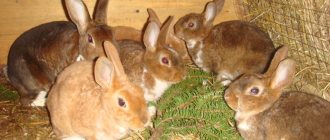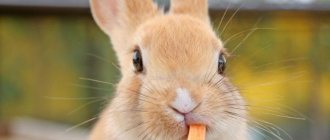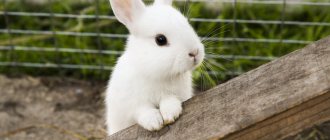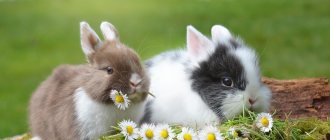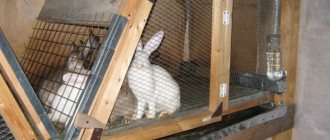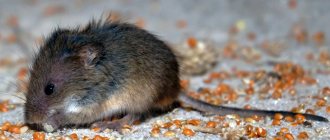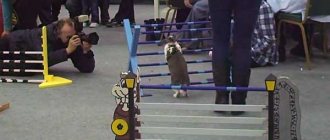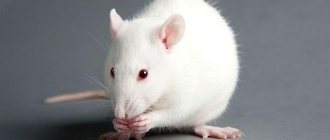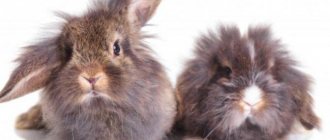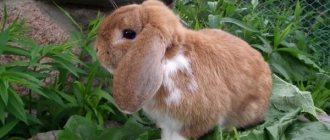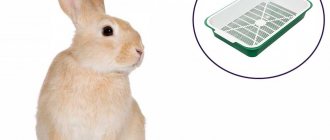Nail trimming is an essential part of caring for your pet rabbit. Some breeders, due to inexperience, believe that trimming is unnecessary or may harm the animal. But this opinion is wrong, because such a procedure, on the contrary, prevents uncontrolled growth and possible problems with the movement of the animal. Haircuts can be carried out at grooming centers or veterinary centers. But if you know some of the nuances, you can even trim your rabbit’s claws at home yourself, and at the same time save money on salon procedures.
Is it possible to trim claws and why should it be done?
It is not only possible, but also necessary to shorten the horny formations of an animal. The procedure is mandatory for the following reasons:
- Since most often the animal moves on a hard plane (the bottom of the cage, the floor), its claws do not sink into such a surface, and the entire load, as a result of improper distribution of weight, falls on the heel. Lack of regular shortening of overgrown claws leads to the appearance of bald spots, wounds and pustules on the back of the paws.
- Long claws interfere with the correct positioning of the animal’s feet while walking, leading to impaired body posture and deformation of the toes.
- In the process of moving, the animal can get caught on various obstacles (carpet, rug, upholstered furniture and others), break or tear out a claw, injuring a finger.
IMPORTANT! When frightened, a rodent may scratch its owner with its long claws or injure itself when it scratches.
Selecting a location
Choosing a place for a rabbit
You should not place a cage with a rabbit near a radiator or near air conditioners. For these pets, any overheating is dangerous. At a temperature of +20°C, rabbits will be very comfortable. Animals are afraid of other pets, computers, TV, bright sunlight, and drafts.
It would be ideal to place the cage away from noise sources and from a window.
It is important that the place is bright and calm. The hallway, kitchen, corridor will not fit
When ventilating the room, avoid drafts. If you place the cage on the loggia, you will increase the likelihood of the animal overheating. Keep in mind that the loggia must have good ventilation and suitable temperature conditions.
For owners of private houses, you can make an enclosure with a canopy and fence it with a small fence. This way, the animal will not be afraid of either rain or overheating, and you can let the rabbit walk outside in the summer.
How often to perform the procedure
The frequency of haircuts depends on the individual characteristics of the animal (for some rabbits it is enough to have a “manicure” once every 2-3 months, while other pets require nail trimming at least once every 3 weeks).
Also, the frequency of trimming horny formations is influenced by the activity of the animal and its place of walking: if a rabbit spends a lot of time outside, its claws will wear down faster and they will not need to be cut as often.
Be sure to inspect your pet’s paws at least 2 times a month - this will help you not to miss the moment and shorten the animal’s claws in time.
ATTENTION! Some of the signs indicating the need for a haircut are the bending of the tips of the claws, the clattering sound that is heard when the pet moves, and the behavior of the rodent: the big-eared cat, experiencing discomfort when moving, begins to gnaw its claws.
Questions about decorative rabbits from beginners
Before purchasing a decorative rabbit, future pet owners ask many questions.
Do decorative rabbits stink?
Young rabbits do not have any unpleasant odor. The fur can only absorb the smell of bedding and food. An unpleasant aroma may come from an adult animal, as sexually mature individuals begin to mark the territory, and old rabbits may emit an odor if they have any diseases. If the animal is provided with proper care and cleaning is carried out regularly, then there will be no reason for the appearance of an unpleasant odor.
How do rabbits sleep?
Rabbits are most active in the morning and evening, and they sleep during the day and at night if nothing disturbs them. They spend 8-9 hours sleeping a day. The animals' eyes are almost always open.
Animals choose a place to sleep individually. Some can sit in the middle of the cage, while others can hide in the corner. Like people, they can be in a light doze, or they can sleep soundly, but they easily wake up from the slightest rustle.
Is it necessary to castrate a decorative rabbit and at what age is the procedure carried out?
Castration for decorative domestic rabbits is a necessary measure. Animals are castrated to avoid unwanted offspring, as well as to prevent the development of diseases of the reproductive system.
Neutered rabbits become calmer and do not show aggression. The operation must be performed between the ages of 4 months and 2 years. Some experts believe that the procedure should not be performed on animals before they reach 6 months of age.
How to trim a rabbit's claws at home
If you have never trimmed an animal's nails before, consult with the pet store seller or the breeder from whom you purchased the pet about the rules and specifics of the procedure. Shortening horny formations is a simple process that can be done at home. However, the procedure requires knowledge and some dexterity on your part: rabbits are very shy, so it is important to act carefully, slowly, so as not to accidentally harm the animal.
Ordinary nail scissors can also handle the claws of a young rabbit.
Tool selection
To trim the claws of a young, two- or three-month-old rabbit, use regular nail scissors. Such a tool will not be suitable for an animal of a more mature age: scissors will bend and crumble a hard claw, rather than cut it. Therefore, when getting a long-eared pet, purchase equipment designed to care for it:
- a nail clipper in the form of a guillotine: the claw is placed in a round hole, after which the handles of the tool are squeezed;
- special scissor cutters with a limiter that prevents the risk of damage to the animal’s blood vessels. They should be used in the same way as regular scissors when trimming nails.
Requirements for devices:
- the blades must be made of steel, have high-quality sharpening, and the cutting edges must fit tightly, without gaps, to each other when the handles are closed;
- It is desirable that the tool handles have rubber pads - this will prevent the devices from slipping out of your hands while working with them.
IMPORTANT! Before starting the procedure and after performing it, be sure to clean your hands, scissors or clippers with rubbing alcohol or another disinfectant solution.
Have you tried cutting your rabbit's nails yet?
Preparation for the procedure
At the initial stage, prepare the necessary tool and position it so that during the work you do not have to reach or stand for it.
Next to the scissors and wire cutters, place medications for disinfection and stopping bleeding in case of capillary damage (hydrogen peroxide, brilliant green or iodine, streptocide tablets), cotton pads, a bandage, a flashlight or a table lamp.
Take your pet out of the cage, take it on your lap, pet it, talk to the animal. It is advisable that by the time the procedure is carried out, the animal is already quite accustomed to you and is not afraid of touching.
Nail trimming should only be done when the animal is completely calm and not trying to escape. When you feel that the rabbit has relaxed and begun to doze, start trimming its claws.
Correct fixation of the rabbit
The optimal and most convenient position for trimming horny formations is the position in which the rodent lies on its back:
- sit on a chair, place the animal with its belly up between your knees, place its head on your bent elbow;
- place the rabbit with its back on the table, lightly press it to the surface with the elbow of your left hand, and use the same hand to hold the paw while cutting;
- if the rodent is restless and breaks out, swaddle its body in a towel, leaving its head outside and taking out its paws one by one to trim its claws. In this case, remove the next limb of the animal from the towel only after you have hidden the treated one.
If your pet is completely unwilling to do the procedure lying down, sit him on the edge of the table, hug him with your left hand, pressing him to you, and perform the haircut in this position.
IMPORTANT! The rabbit's spine is very fragile, so when fixing the animal, act very carefully and do not press too hard on the pet's back.
Haircut procedure
Four claws grow on the rabbit’s paws; on the front limbs there is one more, rudimentary finger, located above the rest on the inside of the paw. All fingers are subject to treatment:
- Inside each claw, in addition to the keratinized part, there is living tissue (pulp) and blood vessels. To avoid damage to the capillary, find the pulp: in the transparent claw it is visible as a pinkish or dark red formation. If the claw is dark, illuminate it from below with a flashlight. Make the haircut at a distance of 4-5 mm from the border of living tissue.
- It is convenient to start the procedure from the forelimbs. Take the rabbit's foot with your left hand and, holding it firmly, place the claw in the guillotine and bite off its edge (the cut should be parallel to the foot). Use the same principle to trim using scissors. Trim each claw in several steps, removing a small amount of dead tissue at a time.
- Treat all the paws one by one, taking a short break after treating the limb (no more than 5 minutes).
- At the end of the procedure, inspect the claws for sharp parts. If necessary, file them with a low-grit nail file.
If the animal starts to get nervous, stop the procedure, pick it up, pet it, and treat it with your favorite treat. Continue pruning only when the animal calms down.
IMPORTANT! After grooming, do not let your rabbit walk outside - dirt can get into microcracks in the claws and lead to the development of fungal diseases. Also disinfect your pet’s home and toilet tray.
If you hit a capillary, stop the procedure immediately
Fixation
There are several ways to restrain a rabbit before trimming its claws. We will look at the best of them now.
- Fixation in a supine position. But this method will only be effective if the animal is accustomed to this position from a young age. In other cases, the animal usually breaks out.
- Fixation in a sitting position on a table. To do this, you need to place the eared one on the edge of the table, to your left. With your elbow, carefully grasp it and lean it against you. The slight tightness reminds him of being in a hole, so he usually calms down quickly. In this position, it is convenient to trim with your right hand, supporting the paw with your left.
- Fixation in a towel. To do this, you must wrap the rabbit like a small child. Leaving only the head outside. Carefully pulling out one paw at a time, trim the claws. Just remember, before pulling out each next leg, the previous one must be hidden back.
- Unfamiliar room. Oddly enough, in an unfamiliar room the animal will behave much calmer. Which makes the task much easier.
It would be best if one more person could help in this matter. Together it is much easier and easier to handle a pet. And it will be less stressful for him.
What to do if a capillary is damaged?
As a result of the inexperience of the owner or a sudden, unexpected movement of the animal, during the process of trimming the claws, the pulp is often damaged with a sharp instrument, resulting in bleeding.
In this case, immediately stop further procedures and provide assistance to your pet:
- treat the wound with an antiseptic (hydrogen peroxide, brilliant green or iodine);
- crush the streptocide tablet into powder and sprinkle the drug on the damaged tissue. This product has disinfectant properties and helps stop bleeding. You can also use a special pencil for these purposes.
- Cut a piece of bandage, place it on the rodent's wounded paw, lightly pinch the limb with your hand and hold it there for several minutes.
It is possible to complete trimming the claws and return the animal to the cage only after the bleeding has completely stopped.
For several days, regularly inspect the injured paw and, if necessary, treat it with an antiseptic. During the healing period, refrain from walking your pet.
IMPORTANT! If bleeding continues for more than 20 minutes, apply a tight bandage to the rabbit’s paw and immediately take your pet to a veterinary clinic or call a specialist at home.
Giving your pet a manicure
It is necessary to prepare for this procedure from the first day of living together. It is easiest to trim nails when the baby rabbit is lying on its back. Therefore, it is gradually necessary to accustom him to this position. Lay your eared one on its back regularly, stroke its tummy and paws, and play.
The first haircut is carried out at the age of 1.3-2.5 months. As a rule, during this period the baby is still in the nursery. If you are purchasing a rabbit whose nails have never been trimmed, ask the breeder to do this in front of you. This way you can get an invaluable practical lesson from a professional. At the same time, find out which tools are best to perform the procedure.
What tools can you use?
There are special nail clippers for trimming cat claws. It is not recommended to use nail scissors. They are designed for thin and flat nail plates of people. Such cutting tools lead to delamination.
There are several types of nail clippers:
- Blisters - resemble nail scissors, but have blades curved at the ends, designed for cat claws.
- Secateurs are equipped with a spring, which is located between the handles. As a rule, such models have a limiter. It allows you to cut only the desired length.
- Guillotines are similar to cigar scissors. The nail is placed in the hole at the end. When the handles are closed, the blade lowers and cuts the claw. The tool is suitable for cats with thick nail plates.
Each owner chooses the model that is convenient for him to use. The main thing is that it is made of high-quality materials and sharpened.
Additionally, you can buy an electric trimmer that allows you to quickly trim your nails. However, not all cats react calmly to it - the buzzing device scares the animals.
First aid for injuries
Despite full compliance with the rules and compliance with the operating algorithm, even an experienced owner can make a mistake. This can be caused by various circumstances: a sharp sound outside the window, a dull nail clipper, or excessive nervousness of the pet.
Don't get upset - it's important to remain calm, apologize to the dog and treat the wound
Pulp cut
Trimming too short greatly increases the risk of damaging blood vessels. This causes severe pain and excessive bleeding. The main task of the owner in case of pulp injury is to urgently stop the bleeding. In addition, it is necessary to calm your four-legged friend - his reaction will be panic and a desire to run away.
The owner should try to distract the animal, switch its attention to something else - perhaps to a toy or a pre-prepared treat. There is no point in screaming at this moment, as the dog is already scared and in pain.
Next you need to treat the wound with hydrogen peroxide. It is not recommended to use alcohol-based solutions - they will only increase the pain and cause a burning sensation.
Antiseptic powder has a good effect. Veterinarians advise having this drug in your pet first aid kit. It is used to treat open wounds and abrasions and copes well with injuries caused during trimming of the nail plate.
Claw detonation
A similar nuisance arises in the case of nervous and uncertain actions of the dog breeder. The dangerous combination of slow compression of the nail cutter along with an unexpected and sharp jerk of the limb during shortening leads to a poor result. Damage to the skin and soft tissues is accompanied by severe pain and fear, and not only from the dog - the owner also experiences nervous shock. However, you should gather your strength and provide first aid to the victim:
- Try to keep the animal in place. Don't shout, but be assertive and speak confidently.
- Next, you need to bandage the injured limb near the metatarsus with a tourniquet or bandage. It is advisable to lift the paw up to stop the bleeding.
- Cold is applied to the damaged surface. You can use an ice pack or frozen food for this.
- Open wounds must be treated with lidocaine or novocaine.
- Sometimes the damage is very severe, so the tear must be stitched. Only a veterinarian can do this.
When transporting an animal to a veterinary clinic, cold should be applied to the damaged area, but at the same time avoid frostbite of the limb.
When and how to cut a guinea pig's nails?
Nail trimming should be done every two to four weeks, starting when your guinea pig is one month old.
Trimming guinea pigs' nails is not difficult, as there are many nail clippers, electric sharpeners and rodent scratching posts available. At a pet store or veterinary pharmacy, you should buy special tweezers - nail clippers for rodents. Before buying, you need to hold it in your hand and make sure that it is comfortable. If you feel uncomfortable, the risk of injury to the animal increases. There are also electric sharpeners that are considered even safer.
There are special nail clippers for this procedure.
